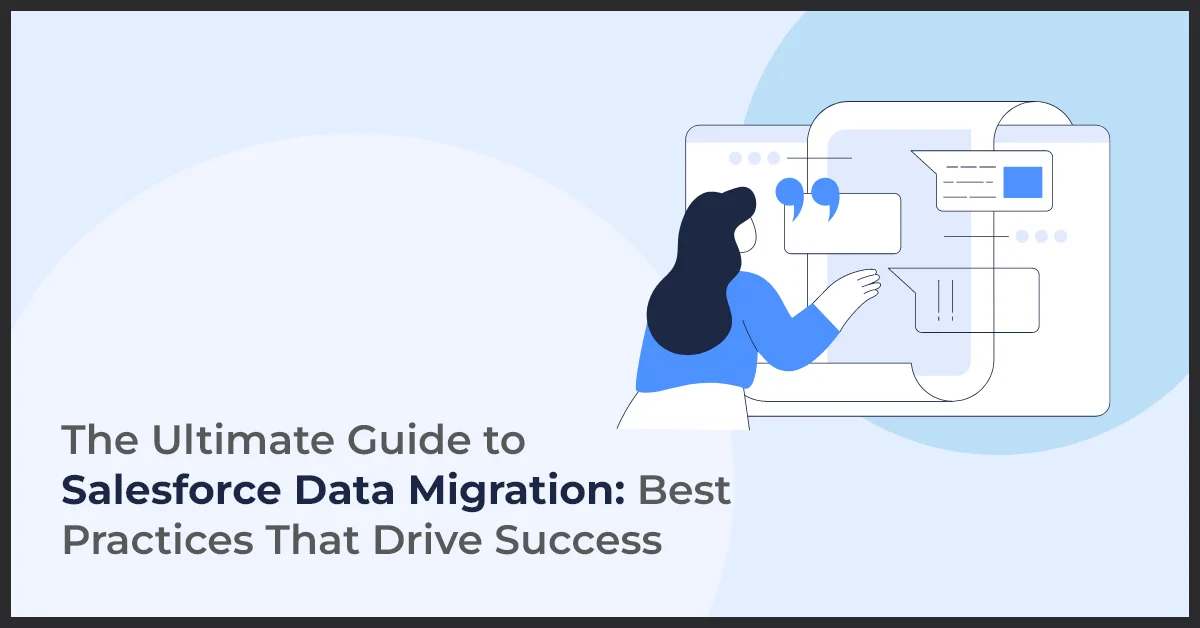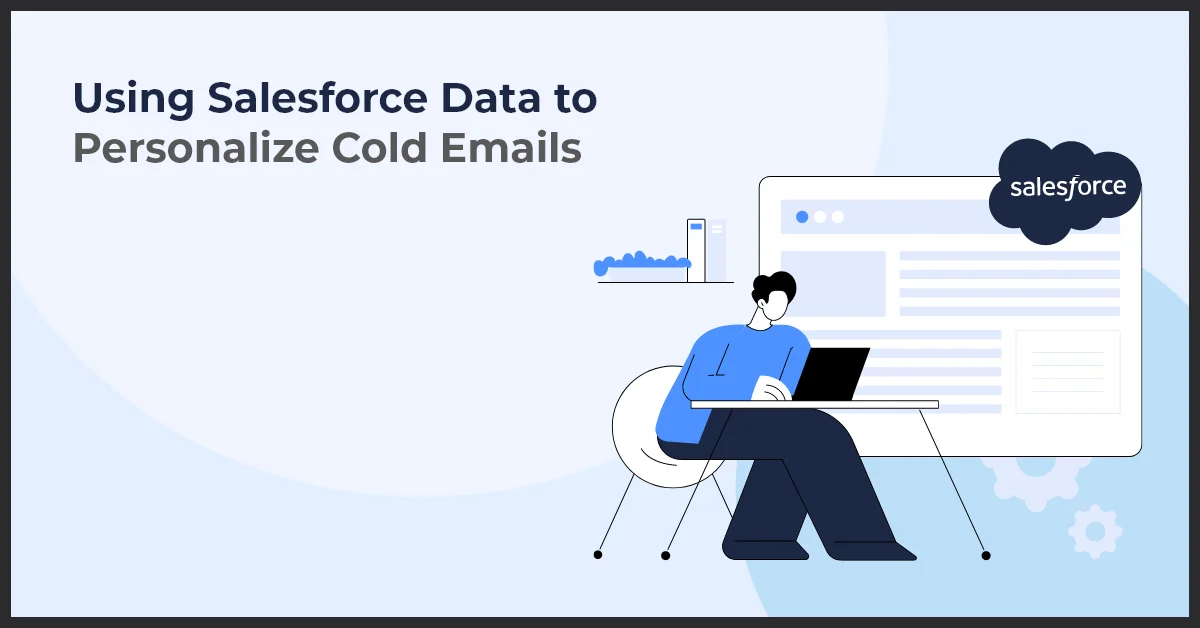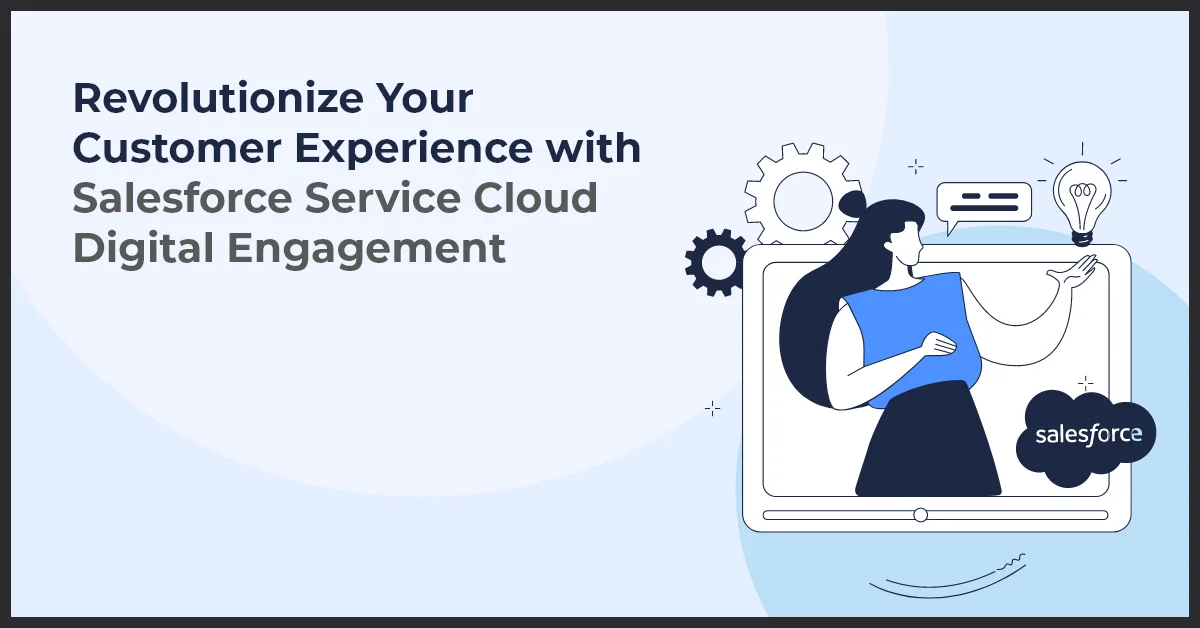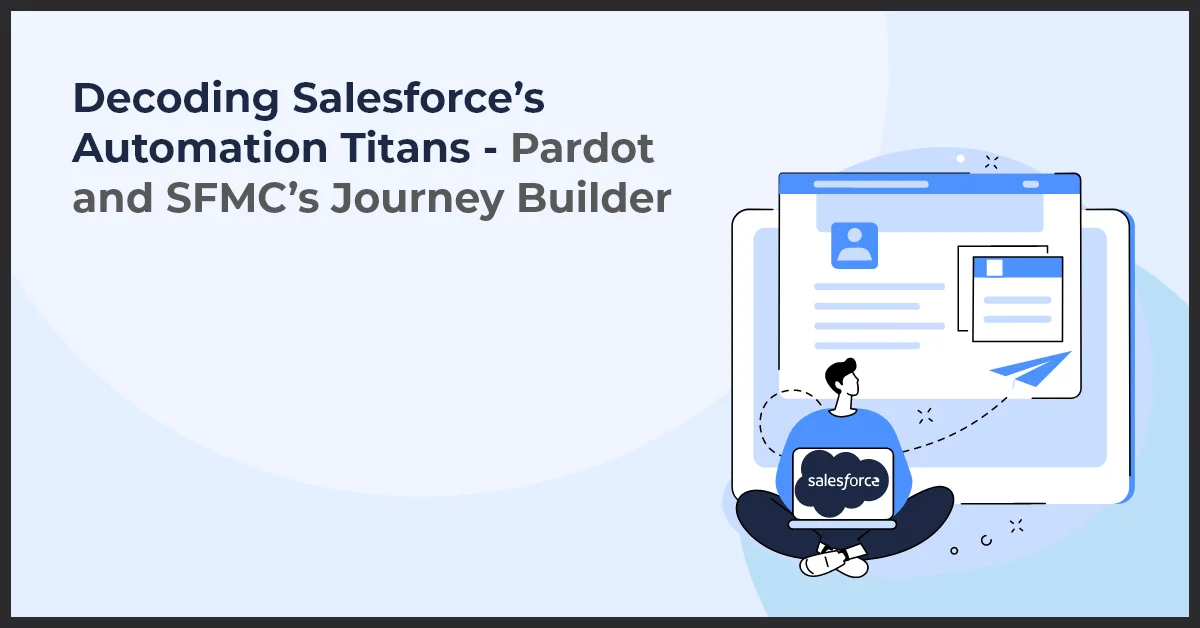The Ultimate Guide to Salesforce Data Migration: Best Practices That Drive Success

Published on: November 16, 2023
Updated on: July 01, 2024
1387 Views
- Salesforce
24 min read
Are you planning to seek Salesforce migration services from a Salesforce marketing cloud agency and want to ensure a seamless transition while avoiding potential pitfalls? Look no further! This comprehensive guide will explore the importance of Salesforce data migration services and the best practices to help you achieve a successful and hassle-free migration process.
Data migration is critical for any business that wants to adopt Salesforce or upgrade to a newer version of this exceptional software for unparalleled market research and analysis. It involves transferring your organization's valuable data into Salesforce while maintaining its integrity and accuracy. Whether you are migrating customer records, sales data, or any other valuable information, a well-executed data migration strategy is key to unlocking Salesforce's full potential and leveraging its powerful capabilities.
However, data migration can be complex and daunting, involving intricate processes, potential data loss, and system downtime. That's why it is essential to partner with a Salesforce marketing cloud agency that follows industry best practices that have proven effective in ensuring a smooth and successful migration.
In the next sections, we will walk you through a set of best practices that will empower you to undertake your Salesforce migration services confidently. From proper planning, data cleansing, and data validation to testing and monitoring, we will cover all the essential steps to help you achieve a seamless migration experience while minimizing risks and maximizing data quality.
Whether you are a Salesforce administrator, IT professional, or business owner, this guide is packed with valuable insights and expertise to help you master the art of rendering or availing Salesforce data migration services and unlock the full potential of your CRM investment.
Understanding Data Migration
Data migration involves transferring data from one system to another, ensuring its accuracy and integrity throughout the process. It is a crucial step in adopting Salesforce migration services, as it allows businesses to leverage and load their existing data and seamlessly transition to the new platform.
Definition and Importance of Data Migration
Data migration refers to transferring data from one system, such as an on-premises database or a legacy CRM system, to Salesforce. It is essential to ensure data is migrated accurately to maintain its usefulness and reliability. Successful data migration is crucial for businesses to make informed decisions, provide better customer experiences, and drive growth.
Key Considerations for Successful Data Migration
When planning to avail of salesforce data migration services from a Salesforce marketing cloud agency, there are several factors to consider to ensure a smooth and seamless transition that offers the desired result:
Identifying the Scope and Goals of Data Migration
Clearly defining the scope and goals of data migration is essential to prioritizing data, determining what needs to be migrated, and establishing objectives for the process.
Understanding the Source and Target Systems
Thoroughly assessing the source system and understanding its structure, software development, data types, and limitations is crucial for mapping and transforming data accurately to the target system, Salesforce. This understanding helps define migration strategies and prevents potential data loss or corruption.
Assessing Data Quality and Integrity
Before initiating the migration process, it is essential to assess the quality and integrity of the data. It includes identifying and resolving data inconsistencies, duplicates, and incomplete or erroneous records. Data cleansing and deduplication techniques should be applied to ensure high-quality data in Salesforce.
The next part will cover the remaining best practices for a Salesforce marketing cloud agency for Salesforce migration services.
Pro Tip: Prioritize thorough assessment and cleansing of data quality before migration to ensure that only accurate and reliable data is transferred to Salesforce, minimizing the risk of errors and optimizing the effectiveness of your new CRM platform.
Planning for Salesforce Data Migration
Data Migration Project Planning
Defining the project objectives and scope before starting Salesforce data migration services and projects will help establish clear expectations and avoid scope creep during migration.
Identifying key stakeholders and roles is another important step in the planning phase. These stakeholders will play a vital role in decision-making, data validation, and addressing any issues that may arise during the migration.
Creating a timeline and setting milestones are essential for keeping the migration project on track. By breaking the project into smaller milestones, you can monitor progress and stay within the planned time frame while achieving optimum personalization and convenience.
Data Mapping and Requirements Gathering
Understanding the structure and organization of your data is key to successful data migration that results in enhanced data utilization. It involves examining the source system and identifying the data fields that must be migrated to Salesforce.
Mapping data fields between the source and target systems is a critical step in the planning phase. It ensures data is accurately transferred to Salesforce, preserving data integrity and minimizing errors.
Identifying data transformation requirements is another aspect of data mapping. It involves determining if any data needs to be modified, converted, or restructured during migration.
Data cleansing and deduplication are important steps to undertake before the migration. It ensures that the migrated data is clean, accurate, and free from duplicate records, improving the overall data quality in Salesforce.
Choosing the right data migration approach is vital to the project's success. Whether you opt for manual migration, automated tools, or both, select the approach that best suits your organization's needs and resources. is crucial
Setting up a dedicated data migration team is beneficial for effective planning and execution. This team should consist of individuals with data migration, Salesforce administration, and IT support expertise.
Preserving data integrity during the migration process is paramount. Implementing data validation rules, performing data checks, and applying proper data mapping techniques can help ensure the accuracy and integrity of the migrated data.
Testing and validating migrated data is critical before going live with Salesforce. It involves extensive testing to verify data accuracy, functionality, and compatibility with existing systems.
Post-migration data reconciliation and cleanup are essential to ensure that all data has been successfully migrated and that no data discrepancies or missing records exist. It is also important to review and resolve any issues, perform data audits, and clean up residual data from the old system.
Thorough planning is a crucial phase of Salesforce migration services. You can ensure a successful and efficient migration process by defining project objectives, identifying key stakeholders, mapping data, selecting the right approach, and prioritizing data integrity.
Pro Tip: Establish a comprehensive data mapping strategy early in the planning phase to ensure accurate and efficient data transfer to Salesforce. It includes identifying data fields, mapping them between source and target systems, and addressing any necessary data transformations, cleansing, and deduplication before migration.
Data Cleansing and Deduplication
Ensure data quality when it comes to Salesforce data migration services. Data inconsistencies and errors can significantly impact the overall success of the migration process. Therefore, data cleansing and deduplication are vital in ensuring data integrity and accuracy in Salesforce.
Assessing Data Quality
Before the Salesforce marketing cloud agency proceeds with the Salesforce migration services, it's essential to assess the quality of your data. It involves identifying data inconsistencies and errors that may exist within your existing data.
Identifying data inconsistencies and errors: Conduct a thorough analysis of your data to identify any inconsistencies or errors. It may include misspellings, incomplete records, or incorrect formatting.
Implementing data cleansing strategies: Once you have identified the inconsistencies and errors, it's time to implement them. It can involve techniques such as standardizing data formats, removing unnecessary characters, and correcting spelling mistakes.
De-duplicating Data
Duplicate data can adversely affect the performance of your Salesforce database and confuse users. Therefore, de-duplicating data is a critical step in data migration.
Techniques for identifying and removing duplicate records: Utilize tools or manual processes to identify and remove duplicate records. It can include comparing fields like name, email, or other unique identifiers.
Best practices for merging and consolidating duplicate data: Once duplicate records are identified, it's crucial to follow best practices for merging and consolidating them. It involves selecting the most accurate and up-to-date record as the primary source and merging other duplicates into it.
By addressing data cleansing and deduplication, you can ensure that your Salesforce data migration services are carried out smoothly with accurate and reliable data. It, in turn, will enhance user experience and improve overall productivity within your Salesforce environment.
Selecting the Right Data Migration Approach
Selecting the right approach for migrating your data is crucial to successfully acquiring Salesforce migration services. The chosen approach will determine how smoothly the migration process will go and how effectively your data will be migrated into Salesforce. Here are some key considerations to keep in mind when selecting the right data migration approach:
Strategies for Data Extraction and Transformation
Understanding different data extraction methods: Before you begin the salesforce data migration services and process, it is important to understand the various methods available to extract data from your current system. Whether through APIs, bulk exports, or direct database queries, evaluate the pros and cons of each method and choose the one that best suits your needs.
Choosing appropriate data transformation techniques: Once you have extracted the data, it may be necessary to transform it to meet Salesforce's requirements. It could involve cleaning and formatting the data, mapping fields, or manipulating complex data. Carefully evaluate the available transformation techniques and choose the ones that align with your data migration goals.
Evaluating Data Migration Tools
Key considerations for selecting the right tool: Numerous data migration tools are available in the market, each offering different features and capabilities. Consider factors like ease of use, data mapping capabilities, support for different data sources, and scalability when evaluating and selecting the tool for your Salesforce migration services.
Overview of popular data migration tools: Take the time to research and understand the popular data migration tools commonly used for Salesforce data migration. Look for tools with a track record of successful migrations and positive user reviews and offer comprehensive support.
By selecting the right data migration approach and Salesforce marketing cloud agency, you can ensure a smooth and efficient migration process, resulting in accurate and reliable data in Salesforce. The next step in the data migration process is setting up a dedicated data migration team, which we will cover in the following section.
Pro Tip: Prioritize thorough research and evaluation of data extraction methods, transformation techniques, and migration tools to select the most suitable approach for your Salesforce data migration project. It ensures seamless data transfer and sets the foundation for a successful migration process.
Data Export Strategies: Getting Your Data Ready to Move
Embarking on a Salesforce data migration journey necessitates a preeminent focus on data export strategies. This phase is pivotal to ensure a harmonious transfer of your business-critical information. Here, we will delve into authoritative methodologies that set the stage for an optimal migration process.
Detailed Methods for Exporting Data from the Current System
There are myriad approaches to data exportation, and identifying the most productive method hinges on the complexity and size of your existing database.
The following are tried-and-true strategies:
- Comprehensive data backup procedures to prevent any loss during extraction.
- Utilization of native data export tools within your current CRM or database system.
- Scripted exports using APIs for more complex and larger datasets.
- Third-party extract, transform, load (ETL) tools for enhanced customization options.
Tools and Services Best Suited for Data Export
Data structure, volume, and specificity dictate the selection of tools and services for data export.
Noteworthy tools include:
- Salesforce Data Loader for larger, more intricate exports directly to and from Salesforce.
- Database-specific tools like SQL Server Integration Services (SSIS) or Oracle Data Pump.
- Cloud-based ETL services that can connect to multiple data sources and consolidate data.
Pre-export Checks to Ensure Data Integrity
Before exporting your data, it's vital to perform exhaustive pre-export checks to certify data integrity.
Points of focus should encompass the following:
- Verify data quality, including accuracy, completeness, and consistency.
- Assuring all relevant data fields adhere to Salesforce data types and constraints.
- Validating the correct sequencing of data so that relational dependencies are preserved.
- Conducting a trial run or partial export to pinpoint potential pitfalls.
In culmination, a profound understanding of data export strategies will arm you with the proficiency to prepare your data for a flawless transition into Salesforce. Meticulous attention to these preliminary steps will imbue your migration endeavor with precision and confidence.
Data Import Strategies: Seamlessly Introducing Your Data to Salesforce
Salesforce data migration is a critical process that requires meticulous planning and execution. With the appropriate import strategies, businesses can ensure a smooth transition of their valuable data into the Salesforce ecosystem. Below, we provide an overview of the import process followed by a step-by-step guide to navigate this crucial phase effectively and advice on handling common challenges that may arise.
Import Process Overview
The data import process into Salesforce involves transferring data from external sources into the Salesforce platform. The process ensures that all your data is accurately and efficiently integrated into Salesforce, allowing you to take full advantage of its robust features.
Step-by-step Guide to Importing Data into Salesforce
- Step 1: Consolidate your data into a compatible format, usually CSV files, to be easily uploaded into Salesforce.
- Step 2: Use Salesforce's Data Import Wizard or Data Loader for larger, more complex data sets.
- Step 3: Map your data fields to Salesforce fields to ensure correct alignment.
- Step 4: Perform a trial import with a subset of your data to test for inconsistencies or issues.
- Step 5: Execute the full import while monitoring the process to address any errors that occur quickly.
How to Handle Common Challenges During Data Import?
- Data Format Mismatch: Ensure your data is appropriately formatted for Salesforce. E.g., dates and email addresses must adhere to Salesforce formats.
- Data Volume: Consider breaking the data into smaller batches for large datasets to avoid system timeouts and performance hits.
- Data Quality: Address duplicates, incomplete records, and inaccuracies before importing to maintain the integrity of your Salesforce database.
By following these strategies, businesses can smoothly introduce their data into Salesforce, setting the stage for successful data migration and optimal use of the CRM platform.
Setting up a Data Migration Team
Roles and Responsibilities
Identifying key team members and their roles
When setting up a salesforce data migration services team, it is important to identify the key team members responsible for various tasks. These team members may include:
- Data Migration Manager: Responsible for overseeing the entire data migration process.
- Data Analysts: Responsible for analyzing and validating data to ensure its accuracy and completeness.
- System Administrators: Responsible for configuring and managing the Salesforce platform to support data migration.
Collaborating effectively within the team
Effective collaboration within the salesforce migration services team is essential for a successful migration. It is important to foster communication and teamwork among team members to ensure the smooth execution of tasks. Regular team meetings, brainstorming sessions, and project management tools help facilitate collaboration and ensure everyone is on the same page.
Communication and Collaboration
Establishing effective communication channels
Open and effective communication channels are crucial for a successful data migration. The salesforce data migration services team should establish clear communication channels like email, instant messaging platforms, and project management tools. Regular meetings should be scheduled to discuss progress, address any challenges, and provide updates to all team members.
Coordinating with business stakeholders and IT teams
Effective coordination with business stakeholders and IT teams is essential for a smooth data migration. The data migration team should work closely with business stakeholders to understand their requirements and ensure the Salesforce migration services meet their expectations. Collaboration with IT teams ensures technical feasibility and successfully integrates the migrated data into the salesforce.
Preserving Data Integrity During Migration
When seeking Salesforce data migration services, it is crucial to prioritize data integrity to ensure the migrated data's accuracy, consistency, and reliability. By preserving data integrity, businesses can avoid errors, protect information integrity, and maintain data quality. Here are some best practices to preserve data integrity during migration:
Ensuring Data Consistency
Validating data integrity throughout the migration process
The first step in preserving data integrity is to validate the data consistently throughout the migration process. It includes verifying the accuracy, completeness, and relevancy of the data being migrated. By conducting regular validation checks, any potential data discrepancies or errors can be identified and rectified promptly. It is important to compare the source data with the migrated data to ensure consistency and integrity.
Implementing data validation rules and procedures
Data validation rules and procedures are essential to maintaining data integrity during Salesforce migration services' availability. They involve defining data quality standards, conducting audits, and establishing data validation processes. By enforcing data validation rules, businesses can minimize the risk of data duplication, inconsistencies, and inaccuracies. Automated data validation tools and techniques can streamline the process and improve efficiency.
Backup and Disaster Recovery
Importance of data backup and recovery plans
Backing up the data before migration is crucial to ensure data integrity. In case of unforeseen errors or issues during the migration, a comprehensive data backup strategy can help restore the data to its previous state. It is recommended that backups be performed regularly throughout the migration process to minimize any potential data loss or corruption.
Strategies for minimizing data loss or corruption
Businesses should implement proactive strategies to minimize data loss or corruption during salesforce data migration services. It includes conducting regular backups, maintaining a data recovery plan, and employing reliable backup and restore methods. Additionally, it is advisable to perform data validation checks after migration to validate the integrity of the migrated data. It helps identify any issues and ensure the accuracy of the migrated data.
By following these best practices, businesses can successfully preserve data integrity during the Salesforce migration services and processes. Prioritizing data consistency and implementing robust backup and disaster recovery plans can significantly reduce the risk of data errors or loss, ensuring a seamless migration experience.
Pro Tip: Regularly validate data integrity throughout migration by comparing the source and migrated data. Implement data validation rules and procedures to minimize the risk of duplication and inaccuracies. Additionally, prioritize data backup and recovery plans to minimize potential data loss or corruption, ensuring a seamless Salesforce migration experience.
Salesforce Data Model Understanding: A Map for Success
A thorough understanding of the Salesforce data model is imperative for data migration. The foundational blueprint shapes how information is organized and interconnected within Salesforce, acting as a map guiding you toward a successful migration journey.
The Architecture of the Salesforce Data Model
The Salesforce data model comprises a complex structure of objects, fields, relationships, and record types that collectively define how data is stored and accessed. Objects like accounts and contacts can be standard or custom and tailored to specific business requirements. Recognizing how these elements integrate is crucial in preserving data integrity and functionality post-migration.
How Does Understanding the Data Model Aid in Migration?
Before migration, comprehending the Salesforce data model helps accurately align your legacy system's data with the Salesforce environment. This knowledge ensures that relationships are maintained, data quality is upheld, and business processes are reflected accurately within your new system.
Practical Tips for Familiarizing with the Salesforce Data Model
- Study the Object Schema
- Use Schema Builder
- Engage with Salesforce Trailhead
- Work with a Developer
- Test in Sandbox
Testing and Validation of Migrated Data
Since you have successfully migrated your data to Salesforce, ensuring its accuracy and integrity is crucial. Testing and validating the migrated data play a vital role in this process.
Importance of Data Testing
Ensuring data accuracy and completeness
The primary objective of data testing is to validate that the migrated data is accurate and complete. It involves comparing the migrated data with the source data to ensure that all information has been recovered during the salesforce data migration services and process.
Validating data integrity post-migration
Data integrity refers to the data's accuracy, consistency, and reliability. You can validate that the relationships between data objects within Salesforce are maintained through testing. It includes checking for any data conversions or discrepancies that might have occurred during migration.
Test Planning and Execution
Creating test scenarios and data sets
Before testing, it is crucial to define test scenarios that cover a range of possibilities, including typical and edge cases. These scenarios should include a variety of data sets to ensure comprehensive testing. Test data should be well-documented with precise instructions to ensure consistency and repeatability.
Conducting thorough testing and resolving issues
Thorough testing involves various tests, such as data validation, functional testing, and performance testing. Testers should execute the test scenarios and compare the results against the expected outcomes. In case of any discrepancies or issues should be documented and resolved promptly, ensuring the migrated data meets the desired quality standards.
Pro Tip: Define diverse test scenarios covering typical and edge cases to ensure comprehensive data testing. Document and execute tests, including data validation and functional testing, comparing results against expected outcomes. Swiftly address discrepancies or issues to maintain data accuracy and integrity during migration.
Post-Migration Data Reconciliation and Cleanup
Once the Salesforce migration services are complete, it is crucial to perform post-migration data reconciliation and cleanup to ensure data accuracy and integrity. This step involves verifying the migrated data against the source data and resolving discrepancies.
Data Reconciliation and Verification
Comparing migrated data with the source
- Identify the key fields and elements that must be compared between the migrated and the source data.
- Utilize data comparison tools and techniques to identify any differences or inconsistencies.
Resolving discrepancies and ensuring data consistency
- Investigate and analyze the reasons for the discrepancies between the migrated data and the source data.
- Implement corrective measures to address the discrepancies and ensure data consistency.
- Update and synchronize the migrated data with the source data to maintain data integrity.
Data Cleanup Strategies
Identifying and resolving data cleanup tasks
- Analyze the migrated data to identify any data quality issues or inconsistencies.
- Create a data cleanup plan that outlines the tasks, priorities, and responsible individuals for resolving the identified issues.
- Utilize data cleansing techniques, such as standardization, matching, and validation, to clean up the data and enhance its quality.
Maintaining data hygiene and ongoing data management
- Establish data governance processes and guidelines to ensure ongoing data hygiene and management.
- Implement data maintenance practices, such as regular data audits, updates, and backups.
- Train and educate the data migration team and users on data management best practices to maintain data quality and accuracy.
Pro Tip: Prioritize data reconciliation and cleanup tasks based on their impact on business operations, first focusing on resolving critical discrepancies to maintain data integrity and minimize disruptions.
Change Management: Navigating Organizational Shifts
Migrating to a new CRM platform such as Salesforce can be a transformative experience for any organization. It involves more than just the technical aspects of moving data; it requires a strategic approach to change management. Successfully navigating the organizational shifts accompanying a Salesforce data migration is crucial for maintaining morale, productivity, and continued business success.
Communicating Changes to Stakeholders
Transparency is key during the migration process. It is important to communicate effectively with all stakeholders, explaining the migration's benefits, expected outcomes, and how it will impact their day-to-day operations. Regular updates and open forums for feedback can foster a culture of trust and inclusion.
Managing Expectations and Mitigating Disruption
Setting realistic expectations is crucial for a smooth transition. From the onset, it's vital to outline the migration timeline, potential challenges, and support structures in place to address them. By preparing your team for these changes and providing the resources to manage them, you can mitigate disruption to business operations.
Maintaining Productivity During the Transition
- Develop comprehensive training programs that cater to different user levels within the organization.
- Establish a clear support system, with experts readily available to assist with any issues during the migration.
- Prioritize maintaining core business functions throughout the migration to prevent performance dips.
- Use strong communication tools to inform and motivate staff members throughout the change process.
Remember, during a Salesforce data migration, change management aims to move data from one system to another and ensure that the organization and its people are equipped to thrive in a new and improved environment.
Data Security Considerations: Protecting Your Assets During and After Migration
Ensuring the security of your data is paramount during Salesforce data migration. The integrity and confidentiality of your business information must be safeguarded throughout the migration journey, from the initial export to the final stages of data integration within the Salesforce environment. Below, we address pivotal elements of data security you need to consider to protect your valuable assets effectively during and after the migration.
Understanding Salesforce Data Security Features
Salesforce offers robust data security features to protect your information at all levels. Understanding and utilizing these features is key to ensuring your data remains secure while leveraging Salesforce's powerful capabilities. Features such as field-level security, profiles, permission sets, and role hierarchies allow you to control data access within your organization meticulously.
Ensuring Compliance with Data Privacy Regulations
Compliance is not optional; it's a mandatory aspect of handling data, especially when moving between systems. Different industries and regions have specific regulations, such as GDPR in Europe or HIPAA in healthcare. It is essential to ensure that the migration process adheres to these regulations to avoid legal or financial repercussions. Salesforce provides tools and features that can aid in maintaining compliance, but it is your responsibility to implement and enforce these measures.
Best Practices for Data Security in a Salesforce Context
When it comes to securing your data within Salesforce, there are several best practices that you should follow:
- Encryption: Use Salesforce Shield or built-in encryption features to protect sensitive data in transit and at rest.
- Regular Audits: Perform security audits and access reviews to ensure only authorized personnel can access sensitive data.
- Minimal Access: Adhere to the principle of least privilege, ensuring users have only the access necessary to perform their role.
- Data Masking: Data masking techniques are used when real data is used in development or testing environments.
- Monitoring and Alerts: Implement monitoring to detect any unusual access patterns or data breaches and set up alerts for immediate response.
Tackling Salesforce data security with a comprehensive approach will protect your assets during migration and establish a strong foundation for future data handling within the platform. Your vigilance and adherence to these security considerations will serve as a bulwark, shielding your assets from both internal and external threats.
Key Takeaways
- Successful Salesforce data migration hinges on meticulous planning. Define clear project objectives, identify stakeholders, map data fields accurately, and select the right migration approach to ensure a smooth transition while preserving data integrity.
- Before migration, assess and cleanse your data rigorously. Address inconsistencies, duplicates, and errors to enhance data quality and reliability, ensuring accurate insights and optimal CRM performance post-migration.
- Set up a dedicated data migration team comprising skilled individuals. Foster open communication, coordinate with stakeholders and IT teams, and prioritize data integrity throughout migration to ensure successful outcomes.
- Prioritize data security at every stage of the migration journey. Utilize Salesforce's security features, adhere to data privacy regulations, and implement encryption, audits, and monitoring to safeguard your valuable assets and maintain regulatory compliance.
Conclusion
Employing Salesforce data migration services doesn't mark the journey's end but rather the beginning of ongoing data maintenance and management. Regularly assess your data quality, ensure data governance, and establish processes for data updates, backups, and security. Continuously monitor and manage your Salesforce data to maintain its accuracy, usability, and integrity. By following these best practices and prioritizing ongoing data maintenance, you can maximize the value of your Salesforce migration services and drive success for your organization.
Need assistance with Salesforce Data Migration? Contact the Salesforce experts at Growth Natives for unparalleled services and solutions. Email us at info@growthnatives.com for more information.
Frequently Asked Questions
Data migration in Salesforce involves transferring data from external sources or legacy systems into Salesforce using tools like Data Loader for Salesforce’s Data Import Wizard. It typically includes extracting data, transforming it to fit Salesforce’s data model, and loading it into the new instance.
Data migration generally includes planning, extracting data from the source, cleansing and transforming it, loading it into the target system, and validating and testing the migrated data to ensure accuracy and integrity.
Data migration can be categorized into various types, including:
- On-premises to Cloud migration
- Legacy system to Salesforce migration
- Database migration (e.g., MySQL to Salesforce)
- Platform upgrade migration (e.g., Salesforce Classic to Lightning)
Data migration aims to transfer data from one system to another, ensuring its integrity, accuracy, and usability. It enables organizations to leverage new technologies, streamline processes, and make informed decisions based on reliable data.
Data migration between Salesforce instances can be done using tools like Salesforce’s Data Loader, Workbench, or third-party solutions. The process involves extracting data from the source instance, transforming it if necessary, and loading it into the target instance while ensuring data integrity and consistency.



